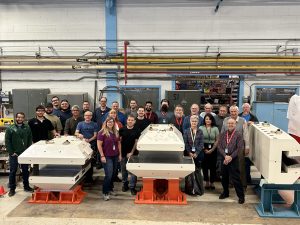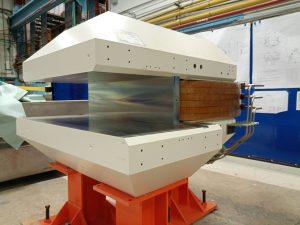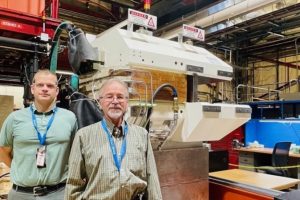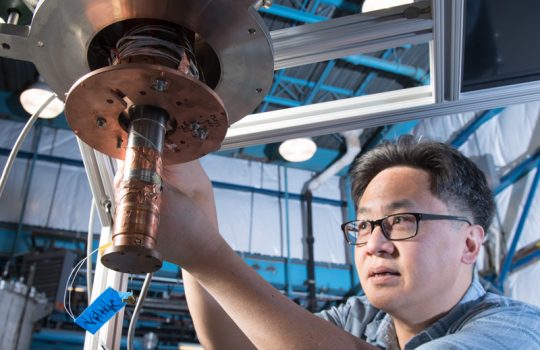In August 2016, Dave Harding received an email. The U.S. Department of Energy’s Oak Ridge National Laboratory needed magnets for a particle accelerator upgrade. These weren’t your usual refrigerator magnets: the scientists at Oak Ridge were looking for large, specially-built, one-of-a kind magnets essential to steering the beam of their particle accelerator. To get these magnets made, Oak Ridge contacted DOE’s Fermi National Accelerator Laboratory. Harding, a senior scientist at Fermilab who led the Accelerator Support Group, took on the project.
“They came to us because of Fermilab’s expertise in designing and building magnets,” said Harding. “It was an engaging challenge because there were a few special things that Oak Ridge needed.”
Fermilab holds a special niche in the DOE system that often leads to collaborations with other national laboratories: Fermilab excels at designing, fabricating and testing magnets for steering, bending and otherwise manipulating particle beams.
Since the initial request, Dave Harding and Thomas Strauss, another Fermilab scientist, have worked with Fermilab’s Magnet Systems Department to lead the design and fabrication of three custom magnets. They are for Oak Ridge’s Proton Power Upgrade to its Spallation Neutron Source.
“These three magnets are right at the heart of the SNS, and a crucial part of the upgrade that we had to get right the first time,” said Nick Evans, accelerator physicist at Oak Ridge. “We knew Fermilab had all of the expertise to design and build these complex, one-off devices and the collaborative spirit we needed to make the most of a partnership like this. We wouldn’t be where we are without their contribution.”

The team at Fermilab poses with the newly completed magnets, ready to be shipped to Oak Ridge National Laboratory. The magnets bear the signatures of the design and fabrication team at Fermilab. Photo: Thomas Strauss, Fermilab
Speedy particles
The SNS is a particle accelerator that creates an abundance of neutrons for research. “The point of it is to slam protons into a target to produce a lot of neutrons, which can then be used to study the properties of various materials and structures that are of interest for a wide range of scientific disciplines,” said Harding.
The SNS consists of four main parts, starting with a linear accelerator that propels a high-intensity beam of negatively charged hydrogen ions (a proton and two electrons). Then, a series of four magnets called a chicane steers the incoming beam onto the path of the circulating beam in the accumulator ring, while a thin foil strips the electrons from the protons. Third, the protons circulate in the accumulator ring until they are ready to be fired at the target, which, lastly, releases the desired neutrons when bombarded with the proton beam.

A close-up of one of the two matching chicane magnets that Fermilab’s Magnet Systems Department built for Oak Ridge’s Spallation Neutron Source. Photo: Jan Szal, Fermilab
The Proton Power Upgrade project aims to double the power of the proton beam hitting the target to create more neutrons to drive research forward. To achieve this goal, Oak Ridge will increase the energy that the H-minus ions have when they exit the linear accelerator by 30 percent and enhance the linear accelerator to handle 50% more particles in each pulse.
The linear accelerator improvements mean that the H-minus beam will have more energy than the current chicane magnet system can handle.
“Injection into the ring is like merging onto an interstate,” said Harding. “You want to keep feeding cars in without disturbing the ones that are already there. With the power upgrade, the system will run with an increased speed. And if your original design had a fairly sharp turn on the entrance — splat!”
The upgraded chicane magnets need to be longer for smoother merging of the higher-energy particles. That requires precise and powerful magnets. The solution: the magnets the Fermilab team designed and built.
Special requirements
The Oak Ridge upgrade team had specific requirements for the magnets that made the designs technically challenging. The SNS accelerator system starts with H-minus ions but then turns them into protons to merge them into the storage ring. This means that the electrons must be removed, and the stripping must happen within the magnets that direct the particles from the linear accelerator into the accumulator ring. The solution: a thin foil filter placed inside the chicane magnet system to knock the electrons off the protons.
However, the electrons that are set free in this process pose a challenge.
“If you did not direct the electrons, they would spiral back on a very tight spiral and smash back into this foil, causing it to deteriorate more quickly,” Harding said. The Fermilab team had to design the magnets so that they direct the electrons away from the foil. “That was a serious three-dimensional challenge. It meant that the top and bottom of the magnet had to be different from each other.”
The strong, room temperature magnets for Oak Ridge are shaped like the letter C. The conducting copper wire wraps around the center of the structure, and the iron magnetic poles reach toward each other with a gap between them. This shape concentrates the magnetic field in that gap and allows for easy access to the magnet’s interior.
The magnets that Fermilab created are asymmetrical images of each other. The top half of the C is smaller than the bottom half in one magnet, and the second magnet is a flipped version of the first.
The team also designed and built a third magnet for the Oak Ridge system. Though the thin foil in the chicane strips off most of the electrons from the protons in the beam, some of the H-minus ions will make it through the filter intact. If any electrons remain on a proton, the particle will have the wrong electrical charge from the rest of the beam; it will not be directed into the accumulator ring with the rest of the beam. The third magnet functions as the off-ramp for those particles.

The third magnet Fermilab created for Oak Ridge’s Spallation Neutron Source, which will combine proton beams before they merge into the accumulator ring. Photo: Sherry Baketz, Fermilab
Putting it all together
In February 2023, Dave Harding turned leadership of the Oak Ridge magnets project over to Strauss, the group leader of Fermilab’s Accelerator Support Group. In addition, the project had recently gained a new lead engineer, Sherry Baketz, and was replacing retiring technicians.
Despite the challenges of bringing new personnel up to speed, the team built the two required chicane magnets by April 2023 and shipped all three magnets to Oak Ridge in August. They were installed in the SNS tunnel in the fall.
“I worked really closely with the technicians to find ways to streamline things,” said Baketz. “It turned out really well. Oak Ridge had their magnets before they needed them, and they work!”
The final step of this project is currently underway; a spare chicane magnet and coil system will be shipped to Oak Ridge this month.
“It’s most exciting when we are actually building the magnet and the coils, just the actual production work,” said Baketz. “You start with nothing, and you end up with this whole magnet. That’s what I like about being a mechanical engineer — turning concepts into reality.”
A mystery

Thomas Strauss (left) and Mike Tartaglia stand next to the spare chicane magnet while it sits on the testing stand at Fermilab. Photo: Lisa Roberts, Fermilab
Before sending the magnets to Oak Ridge, a Fermilab team from the Test and Instrumentation Department did a detailed measurement of the magnets and made sure they met all required specifications.
“An Oak Ridge review of this project just gave us some very high praise for the work that we have done,” said Mike Tartaglia, the former head of the T&I Department and now head of the Magnet Test Support Group.
At the same time, the T&I team noticed something that is of scientific interest.
“We measured all three of the magnets,” said Tartaglia. “With the first magnet, we took some preliminary measurements to check whether the field distribution looked correct. We found some regions where the field is not identical to what the model simulated.”
Though the deviations they found won’t affect the Oak Ridge beam, they’re still an intriguing mystery for Tartaglia.
“I have a few ideas about what these deviations could be. I’m excited to analyze the testing data and understand this slight anomaly compared to the model.”
Future collaborations
With this project coming to a close, the Magnets Systems Department has begun to look toward its next collaborations with Oak Ridge and other DOE national laboratories.
“We are currently in the early stages of working with the Second Target Station project at Oak Ridge,” said Harding. The project will add a second neutron source to the SNS that will generate high-brightness, cold neutrons. “There, the challenges are different, but they’re interesting magnets; they could be twice the size, about two meters high.”
Fermilab’s magnets team is also partnering with other labs, including DOE’s SLAC National Accelerator Laboratory and the European laboratory CERN.
“Oak Ridge has been a great partner,” said Strauss, who will manage future magnet collaborations. “It’s always nice to work with people in other labs because there’s a very similar mindset, but you have different capabilities. We have some upcoming work for other national labs because Fermilab has the expertise in the DOE system to make these unconventional magnets.”
The Proton Power Upgrade project of the Spallation Neutron Source is funded by the Basic Energy Science program of the DOE Office of Science.
Fermi National Accelerator Laboratory is supported by the Office of Science of the U.S. Department of Energy. The Office of Science is the single largest supporter of basic research in the physical sciences in the United States and is working to address some of the most pressing challenges of our time. For more information, please visit science.energy.gov.


